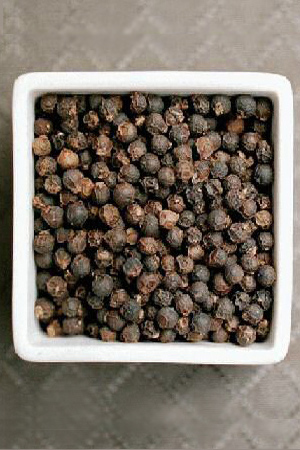

Talamanca del Caribe peppercorns. Photo courtesy Pepper-Passion.com.
| WHAT IT IS: Varietal peppercorns—20 different pepper types and counting. |
|
WHY IT’S DIFFERENT: Each origin of the world produces pepper with different aromas and flavors—just like coffee beans and chocolate.
|
| WHY WE LOVE IT: Another way to vary food accents—and it has no calories! |
| WHERE TO BUY IT: Pepper-Passion.com, Kalustyans.com. |
|
|
|
KAREN HOCHMAN is Editorial Director of THE NIBBLE.
|
|
|
 |
Varietal Peppercorns: Spice Up Your Life
Page 3: What’s Wrong With Supermarket Pepper
This is Page 3 of an 11-page article. Click on the links below to visit other pages.
What’s Wrong With Supermarket Pepper
Most pepper-producing countries grow the crop as a commodity, to be sold at a prefixed price per ton. Margins are slim, there’s no bonus paid for quality and there’s no room for error: The longer the berries are left on the vine, the greater the risk of birds or storms imperiling the crop.
The berries are picked as soon as they form on the vine, resulting in meager little peppercorns whose flavors have not had a chance to develop—like a tomato that is picked from the vine too early. Brazil produces a large commodity crop; much of the black peppercorns sold in our supermarkets comes from there. (However, quality green peppercorns come from Brazil as well.)
In other countries, like India and Malaysia, fine pepper is part of the cultural heritage. Malabar, Tellicherry (both from India) and Sarawak (Malaysia) corns are of moderate to large size and have the bold, rich flavors that make them “gourmet” pepper.
Growing and harvesting the pepper crop is artisanal work: The knowledge gained over centuries of farming and processing peppercorns continues to evolve. Traditionally, for example, fine peppercorns are dried in the sun for about a week. But it has been found that sun-drying evaporates a good portion of flavor, while indoor drying with hot air retains it. As a result, the Ministry of Agriculture of Sarawak, the largest state in the Federation of Malaysia, is helping farmers to build this capability. In India, sheltering the pepper from the elements produces more fully-flavored, cleaner peppercorns—a technique developed at the request of German sausage-makers who wanted extra-clean pepper for their cold-curing process, and were willing to pay more for it.
When you start to taste gourmet pepper, you’ll discover layers of flavor—berries, citrus and other spice flavors from cinnamon to anise—and aromas that give these peppercorns star power. We enjoyed eating them “straight”—crunching down on the corns—while writing this article.
So, the next time you go to purchase pepper and see what looks like price value on generic peppercorns, you’ll know why. It doesn’t pay to buy giant bottles of peppercorns at price clubs. |
 Kalimantan (Borneo)
Kalimantan (Borneo)
Sarawak is one of the two states plus a federal territory that comprise the nation of Malaysia, which shares the island of Kalimantan (Borneo) with the nation of Indonesia and the sultanate of Brunei. There are other Malaysian states and
territories on the Asian mainland. Kalimantan is the third largest island in the world; “Borneo” is a Western name bestowed by the Dutch during their colonial period and is never used locally. Map courtesy Wikipedia.
|
First, they’re not likely to be top-quality.
Second, even if the bottle says “Tellicherry,”** pepper loses flavor and aroma through evaporation and exposure to light. Keeping a jumbo jar on the shelf for three years to save a few dollars is not doing yourself a service. You might as well buy the best. A few peppercorns go a long way—how often do you refill your peppermill?
**It is worth noting that, as with any region-designated product, not all products are created equal. There is no one uniform “Tellicherry” as there is no uniform “Kona”: Different producers grow and process products that have different qualities. Spice merchants may carry some “top of the line” offerings within a varietal.
Read more about the different types of Piper nigrum—black, white and green—and other spices called “pepper,” in the next section.
Continue To Page 4: Peppercorn Glossary A & B
Go To The Article Index Above
FOR ADDITIONAL INFORMATION, special offers, contests, opinion surveys, THE NIBBLE back issues archive, product gift-finder and more, visit the home page of TheNibble.com.

|





